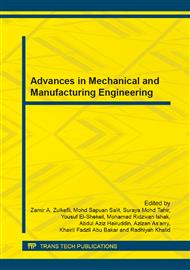[1]
M.H.F. Zarandi, et al., The International Journal of Advanced Manufacturing Technology, Vol. 56 (2011), pp.809-821.
Google Scholar
[2]
M.P. De Brito and R. Dekker, in: A framework for reverse logistics, Springer (2004).
Google Scholar
[3]
B. Lebreton, Strategic Closed-Loop Supply Chain Management, (2007), pp.67-96.
Google Scholar
[4]
B. Lebreton, Strategic closed-loop supply chain management, Springer, Vol. 586 (2006).
Google Scholar
[5]
H. Stadtler, European Journal of Operational Research, Vol. 163 (2005), pp.575-588.
Google Scholar
[6]
S.K. Srivastava, Omega, Vol. 36 (2008), pp.535-548.
Google Scholar
[7]
M. Pishvaee and S. Torabi, Fuzzy Sets and Systems, Vol. 161 (2010), pp.2668-2683.
Google Scholar
[8]
M.I.G. Salema, et al., Spectrum, Vol. 31 (2009), pp.573-599.
Google Scholar
[9]
J. D. Linton, et al., Journal of Operations Management, Vol. 25 (2007), pp.1075-1082.
Google Scholar
[10]
W.C.O., Environment and Development, ed: Oxford University Press Oxford(1987).
Google Scholar
[11]
A.P. Barbosa-Póvoa, Computer Aided Chemical Engineering, Vol. 27 (2009), pp.127-132.
Google Scholar
[12]
J.Q.F. Neto, et al., International Journal of Production Research, Vol. 48 (2010), pp.4463-4481.
Google Scholar
[13]
S. Seuring, Decision Support Systems, Vol. 54 (2013), pp.1513-1520.
Google Scholar
[14]
H. Winkler, CIRP Journal of Manufacturing Science and Technology, Vol. 4 (2011), pp.243-246.
Google Scholar
[15]
P.R. Kleindorfer, et al., Production and Operations Management, Vol. 14 (2005), pp.482-492.
Google Scholar
[16]
S.H. Amin and G. Zhang, Expert Systems with Applications, Vol. 39 (2012), pp.6782-6791.
Google Scholar
[17]
A. Gupta and G. W. Evans, Engineering optimization, Vol. 41 (2009), pp.713-735.
Google Scholar
[18]
D. Peidro, et al., The International Journal of Advanced Manufacturing Technology, Vol. 43 (2009), pp.400-420.
Google Scholar
[19]
M.S. Pishvaee and J. Razmi, Applied Mathematical Modelling(2011).
Google Scholar
[20]
M. Thierry, et al., California management review, Vol. 37 (1995), pp.114-135.
Google Scholar
[21]
B.M. Beamon and C. Fernandes, Production Planning & Control, Vol. 15 (2004), pp.270-281.
Google Scholar
[22]
G. Liu and J. Wu, in Software Engineering and Service Science (ICSESS), 2011 IEEE 2nd International Conference(2011), pp.761-764.
Google Scholar
[23]
E. Akçalı, et al., Networks, Vol. 53 (2009), pp.231-248.
Google Scholar
[24]
S. Gupta and O.D. Palsule-Desai, IIMB Management Review, Vol. 23 (2011), pp.234-245.
DOI: 10.1016/j.iimb.2011.09.002
Google Scholar
[25]
G.C. Souza, Decision Sciences, (2012).
Google Scholar
[26]
V.V. Agrawal, et al., Management Science, Vol. 58 (2012), pp.523-533.
Google Scholar
[27]
C. Kahraman, et al., Logistics Information Management, Vol. 16 (2003), pp.382-394.
Google Scholar
[28]
S. Seuring, et al., Journal of Cleaner Production, Vol. 16 (2008), pp.1545-1551.
Google Scholar
[29]
P. Humphreys, et al., Journal of Materials Processing Technology, Vol. 138 (2003), pp.349-356.
Google Scholar
[30]
W. Ho, et al., European Journal of Operational Research, Vol. 202 (2010), pp.16-24.
Google Scholar


